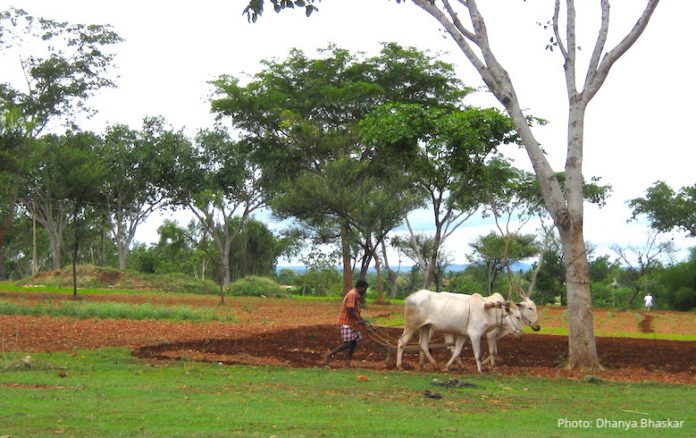By Dhanya Bhaskar & Charuta Kulkarni
The COVID-19 pandemic is a game-changer of sorts for India. Urban growth that promised to catapult the country into a trillion-dollar economy has taken a severe beating. Instead, what is now emerging is an intriguing picture of rural India, morphing into the recovery and growth engine of the country.
This shift is not surprising as immense liquidity has been pumped into the rural sector to alleviate the fallout of the largest reverse migration the country has ever witnessed. For instance, the Garib Kalyan Rojgar Yojana (GKRY), a Rs 50,000-crore government relief package was released in June 2020 in six states that received the maximum number of returnees. With a 65% boost for its well-matured older sibling, The Mahatma Gandhi National Rural Employment Guarantee Scheme, the GKRY envisioned immediate employment of 6.7 million migrant workers in accelerating 25 kinds of public works including village roads, sanitation complexes, and ‘green’ tasks such as plantation, compensatory afforestation, and horticulture.
How do we leverage this massive influx of labour and liquidity to trigger sustainable transformations in rural livelihoods and landscapes? How do we avert a potential surge in unimaginative tree plantations under rural employment schemes, often displacing food crops and expropriating ecological commons? The answers lie in reorienting afforestation to ‘agroforestation’ in building back while going resilient.
Why agroforestry and why talk now?
Agroforestry i.e. maintaining trees on farmlands is among the most promising, multi-functional land management strategies practiced worldwide. An appropriate combination of trees and crops and their synergistic interactions optimise farm productivity in highly fragmented tropical landholdings. Tree products supplement income and act as safety nets for farmers when crops fail.
Agroforestation is a win-win for people and the planet.
Although often underappreciated, sharing of fruits, fodder, and fuelwood from trees enhance the subsistence of rural communities. More trees in the landscape also mean more habitats for wild species outside formally protected areas, nurturing all-round ecosystems. Combining all that with other global goods and services including regulation of water cycle, protection of soil, and climate change mitigation, agroforestation is a win-win for people and the planet.
India has recognised the multifarious social-ecological benefits of agroforestry and became the first country to adopt a National Agroforestry Policy (NAP) in 2014. The goals have been set to increase the area under agroforestry to enhance agricultural productivity as well as rural subsistence while making landscapes climate-resilient. Subsequently, the rationale of the NAP has been overwhelmingly enunciated in the context of reducing import dependence of raw material for wood-based industries and achieving the national tree cover target of 33%.
Meanwhile, India also committed to creating an additional sink of 2.5-3 billion tonnes of CO2 equivalent by 2030 as the country’s Intended Nationally Determined Contribution under the 2015 Paris Climate Agreement; again, the proposed tool is tree planting. Corollary to these commitments, significant bolstering of tree growth on farmlands is imperative sooner than later.
However, prioritizing timber productivity and carbon sequestration as policy targets often imply a boom in ‘fast-wood’ forestry of exotic species such as Eucalyptus and Casuarina that quickly remove carbon from the atmosphere and grow. Aquifer-sucking monocultures of low biodiversity value dubbed as carbon farms, in place of native trees that fulfil fuel, fodder, fertilizer, and fiber needs of the community could be the perverse local outcomes of a noble global cause. With all visible and invisible challenges, the COVID-driven rebuilding initiative is a timely opportunity to reimagine the green rural employment sector through well-calibrated, diverse agroforestation.
Taking Cinderella to the ball
So, what to keep in mind during agroforestation under the government schemes? Not all trees are equal, and each ecosystem is unique. It is crucial that locally suited multipurpose tree species are given precedence along with indigenous varieties of crops. Duly called as ‘Cinderella’ species, these orphan trees are treasure troves of ecological, social, cultural, and livelihood benefits that our modern forestry and agriculture programmes have snubbed in favour of a few exotic, fast-growing, quick-buck species.
Each agroecological zone of India has a Cinderella species, be it Khejri (Prosopis cineraria) in Rajasthan, Babul (Acacia nilotica) in Central India, Velvelam (Acacia leucophloea) in Tamil Nadu or Ficus trees that dot semi-arid landscapes in Karnataka. ‘Investing’ the wide genetic variations of these species into participatory domestication programmes could help propagate quality planting material of their locally optimal varieties. Giving these Cinderellas a fair chance would turn agro-ecosystems diverse and resilient.
Skill-mapping of returnee laborers has been initiated under rural employment schemes including the GKRY. Skills for agroforestation equate to indigenous knowledge of tree varieties and managing tree-crop combinations; both should be drawn into mapping exercises. Most returnees would have a considerable understanding of the local landscapes, having lived there before migrating and keeping in touch for years.
Mobilization of women as decision-makers is vital for effective agroforestation as women possess rich traditional knowledge about trees.
In cases where prolonged absence necessitates reskilling, in situ collectives including experienced locals can enable knowledge-sharing. The mobilization of women as decision-makers is equally vital for effective agroforestation programmes. Women possess rich traditional knowledge about trees and are more cognizant about domesticating trees rendering dietary supplements, fuelwood, and fodder. The ability of agroforestation programmes to appreciate the plurality of values that diverse stakeholders attribute to trees is a crucial determinant of their success, positively influencing future reforms.
Thinking agroforestation far and loud
Despite its long-lasting social-ecological-economic benefits, making tree-growing attractive to individual farmers has always been a key challenge. Experiences of organizations that have been actively promoting agroforestry in India (BAIF Development Research Foundation, Deccan Development Society, Lok Kalyan Parishad, etc.) indicate requirements of long-term planning with more intensive local facilitation, training, and monitoring compared to other plantation programmes like social forestry; timely inputs of materials and labour for tree planting, protective irrigation for saplings and watch-and-ward from browsing animals, allaying negative perceptions of small landholders about tree shade causing crop loss; all need to be addressed for scaling up agroforestry adoption.
On the other hand, proper institutional architecture has remained a major issue, tied to overlapping jurisdictions of agriculture and forest departments over trees on farms. The NAP clearly states that the Ministry of Agriculture has the mandate for agroforestry and an Agroforestry Mission/Board will be established in the Department of Agriculture and Cooperation. However, the policy is yet to result in robust local-level institutional mechanisms for agroforestry, yet another reason to further advocate and push for systemic change.
While rural employment schemes including the GKRY can provide the much-needed dose of labour, popularizing Cinderella species on farms would necessitate several other incentives to farmers including secure rights over land and trees, relaxation of restrictive rules on harvest and transport of timber, marketing support for tree products, and payment mechanisms factoring in multiple ecosystem services of trees to compensate for any short term crop loss and to promote their retention. Evolving a ‘social fencing’ plan stipulating time and location for livestock grazing could preclude conflicts with livelihood needs of pastoralists and ensure sustained community collaboration for agroforestation.
On a global scale, the opportunities for innovative policy and institutional changes to promote agroforestry are tremendous. We are living through the decades of family farming (2019-2028), action on nutrition (2016-2025), and water action (2018-2028), declared by the United Nations (UN) in pursuance of the Sustainable Development Goals by 2030. The goals of each will considerably gain from dovetailing with agroforestry initiatives as substantiated in the Montpellier Declaration of the 4th World Congress on Agroforestry 2019.
The UN decade of ecosystem restoration (2021-2030) aims to massively escalate the restoration of degraded ecosystems for which agroforestry holds immense potential. The practice of farmer-managed natural regeneration (FMNR) i.e. encouraging sprouting of trees from stumps, roots, and seeds found in degraded soils, is a promising approach where tree planting is not feasible. FMNR is already credited for regreening 5 million hectares of degraded land in Niger and augmenting grain yields by 30%. Making a way towards India’s pledge to restore 5 million hectares of degraded land by 2030, similar low-tech and low-cost practices for tree propagation are to be customized for each zone, carefully evaluating the ecological constraints and endowments.
Multi-functional agroforestry landscapes including diversified crops, trees, and animals are keys to social-ecological resilience. If current government reforms indeed succeed in the retention of a considerable fraction of the rural workforce, subsequent scaffoldings are capable of perpetual greening of India’s rural employment sector. The self-sufficiency of these livelihoods is intertwined with the ecological integrity of landscapes themselves. If agroforestry is the path to sustainable landscapes and livelihoods, it is the path to self-reliant India in a post-COVID world.
(Dhanya Bhaskar is a faculty at Azim Premji University, Bengaluru, India, and Charuta Kulkarni is a European Union Marie Curie Fellow, currently based in London, United Kingdom. A shorter version of this commentary appeared as an opinion piece in Deccan Herald on 28 July 2020)











